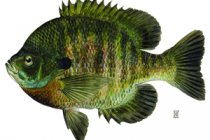
Erie Canal: East and West
Erie Canal East:
Erie Canal East originates near the intersection of Kinne and Butternut Roads in the Town of DeWitt (near the DeWitt Town Hall), and extends eastward through DeWitt and the Town of Manlius, past Green Lakes State Park, towards the Village of Chittenango in Madison County.
Most of the Canal along Cedar Bay Road and Green Lake Road is designated as a portion of the Old Erie Canal State Park, and has an adjacent gravel- covered walking and bicycle pathway (the Erie Canalway Trail). The Erie Canal Trail is accessible from local roads crossing the Canal, and from adjacent town and state parks. The entire path of the Old Erie Canal is easily accessible to the public, including access with canoes or kayaks.
The Erie Canal can be fished along the entire length of the adjacent pathway, and at the various road intersections in DeWitt and Manlius. There are also several widened sections of the canal (“Widewaters”) that were historically used as turning areas for former canal boats. These areas are open ponds that can be fished like any large farm pond.
Popular fish species in the Erie Canal East include largemouth bass, pickerel, carp, perch, sunfish and other panfish.
Erie Canal West:
The original Erie Canal flowed east and west through the City of Syracuse, but that urban portion within the City has been paved over. The Old Erie Canal picks up again on the west side of Syracuse at Warners Road in the Town of Camillus, and extends westward past the Village of Camillus, through the Towns of Camillus, Van Buren and Elbridge. The Canal’s path continues through the Village of Jordan in Onondaga County; towards the Villages of Weedsport, and Port Byron in Cayuga County.
As with the Erie Canal East, a walking and bicycle pathway is located adjacent to the western portion of the Erie Canal in Onondaga County as well. Once again, public access is available at various road crossings along the Erie Canalway Trail, and at several village or town parks in both Camillus and Elbridge.
Popular fish species in Erie Canal West are essentially the same as in the eastern portion, with the addition of northern pike in some locations.




